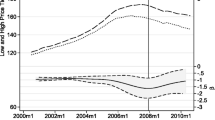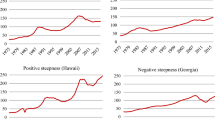Abstract
This paper investigates the extent to which condominium apartment prices are set in an efficient asset market. Unlike previous work that focuses on the time-series properties of measures of excess returns, the analysis is framed in terms of the changes in observable house prices over time. More precisely, the paper develops and applies a test of the joint null hypothesis of rational expectations, perfect markets, and no risk premium in the Vancouver condominium apartment market. The empirical results provide significant evidence against the joint null hypothesis. On average, ex post house price changes move in a direction opposite to their rational expectation. This approach offers a methodological advantage over the standard efficiency literature and is shown to provide a more powerful test of market efficiency than conventional return regressions. Another contribution of the paper is to characterize the time-series properties of deviations of condominium prices from those predicted by the risk-neutral rational expectations model, using cointegration and random coefficients techniques. Deviations in house price changes from their (risk-neutral) rational expectations are time varying, stationary, and related to the stage of the real estate price cycle.
Similar content being viewed by others
References
Case, K. E., and R. J. Shiller. (1988). “The Behaviour of Home Buyers in Boom and Post-Boom Markets,” New England Economic Review, Federal Reserve Bank of Boston, November-December, 29–46.
Case, K. E., and R. J. Shiller. (1989). “The Efficiency of the Market for Single-Family Homes,” American Economic Review 79, 125–137.
Case, K. E., and R. J. Shiller. (1990). “Forecasting Prices and Excess Returns in the Housing Market,” Journal of the American Real Estate and Urban Economics Association 18, 253–273.
Clayton, J. (1996). “Rational Expectations, Market Fundamentals and Housing Price Volatility,” Real Estate Economics 24, 441–470.
Davidson, R., and J. MacKinnon. Estimation and Inference in Econometrics. Oxford University Press. New York. 1993.
Dickey, D., and W. Fuller. (1979). “Distribution of the Estimators for Autoregressive Time Series with a Unit Root,” Journal of the American Statistical Association 74, 427–431.
Engle, R., and C. W. J. Granger. (1987). “Cointegration and Error Correction: Representation, Estimation and Testing,” Econometrica 55, 251–276.
Gau, G. (1984). “Weak Form Tests of the Efficiency of Real Estate Investment Markets,” The Financial Review 19, 301–320.
Gau, G. (1985). “Public Information and Abnormal Returns in Real Estate Investment,” Journal of the American Real Estate and Urban Economics Association 13, 15–31.
Gau, G. “Efficient Real Estate Markets: Paradox or Paradigm?”Manuscript of a presidential address delivered to the American Real Estate and Urban Economics Association 1986.
Geltner, G. (1989). “Estimating Real Estate's Systematic Risk from Aggregate Level Appraisal-Based Returns,” Journal of the American Real Estate and Urban Economics Association 17, 463–481.
Giliberto, S. M. (1988). “A Note on the Use of Appraisal Data in Indexes of Performance Measurement,” Journal of the American Real Estate and Urban Economics Association 16, 95–104.
Glejser, H. (1969). “A New Test for Heteroskedasticity,” Journal of the American Statistical Association 64, 316–323.
Hamilton, B., and R. Schwab. (1985). “Expected Appreciation in Urban Housing Markets,” Journal of Urban Economics 18, 103–118.
Hamilton, S. W. (1989). “Condominiums: Market Performance and Penetration,” Resource: The Canadian Journal of Real Estate 31–37.
Hamilton, S. W., and D. Hobden. Residential Market Behaviour: Turnover Rates and Price Performance. Vancouver: Laurier Institute. 1992.
Hansen, L. P. (1982). “Large Sample Properties of Generalized Method of Moments Estimators,” Econometrica 50, 1029–1054.
Hansen, L. P., and R. J. Hodrick. (1980). “Forward Exchange Rates as Optimal Predictors of Future Spot Rates: An Econometric Analysis,” Journal of Political Economy 88, 829–853.
Harvey, A. C. The Econometric Analysis of Time Series, 2nd ed. Cambridge, MA: MIT Press. 1990.
Hosios, A. J., and J. E. Pesando. (1991). “Measuring Prices in Resale Housing Markets in Canada: Evidence and Implications,” Journal of Housing Economics 1, 303–317.
Mankiw, N., and D. N. Weil. (1989). “The Baby Boom, the Baby Bust and the Housing Market,” Regional Science and Urban Economics 19, 235–258.
Meese, R., and N. Wallace. (1994). “Testing the Present Value Relation for Housing Prices: Should I Leave My House in San Francisco?” Journal of Urban Economics 35, 245–266.
Newey, W. K., and K. D. West. (1987). “A Simple, Positive Semi-Definite, Heteroskedasticity and Autocorrelation Consistent Covariance Matrix,” Econometrica 55, 703–708.
Phillips, P. (1987). “Time Series Regression with a Unit Root,” Econometrica 58, 165–193.
Phillips, P., and P. Perron. (1988). “Testing for a Unit Root in Time Series Regression,” Biometrika 75, 335–346.
Poterba, J. M. (1991). “House Price Dynamics: The Role of Tax Policy and Demography,” Brookings Papers on Economic Activity 2, 143–203. Royal Lepage Real Estate Services Ltd. Royal Lepage Survey of Canadian House Prices, various issues.
Scheifer, A., and L. H. Summers. (1990). “The Noise Trader Approach to Finance,” Journal of Economic Perspectives 2, 19–33.
Shiller, R. J., and P. Perron. (1985). “Testing the Random Walk Hypothesis: Power versus Frequency of Observation,” Economics Letters 18, 381–386.
Stock, J. H. (1987). “Asymptotic Properties of Least Squares Estimates of Cointegrating Vectors,” Econometrica 55, 1035–1056.
Stock, J. H., and M. Watson. (1988). “Variable Trends in Economic Time Series,” Journal of Economic Perspectives 2, 147–174.
White, H. (1980). “A Heteroskedasticity-Consistent Covariance Matrix Estimator and a Direct Test for Heteroskedasticity,” Econometrica 48, 817–838.
Author information
Authors and Affiliations
Rights and permissions
About this article
Cite this article
CLAYTON, J. Are Housing Price Cycles Driven by Irrational Expectations?. The Journal of Real Estate Finance and Economics 14, 341–363 (1997). https://doi.org/10.1023/A:1007766714810
Issue Date:
DOI: https://doi.org/10.1023/A:1007766714810




